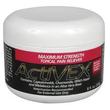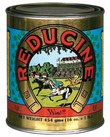Pronunciation
ray-DOO-seen - Pronunciation guide
Brand names
- Reducine Absorbent for Horses
Description
Reducine is a counterirritant for use as an aid in the temporary relief of minor stiffness or soreness caused by overexertion.
Usage
As a blistering agent
The principal use of Reducine is as a counterirritant. A counterirritant is a substance which creates inflammation in one location with the goal of lessening the inflammation in another location. In the case of the horse, the Reducine is applied to the skin of a sore limb, causing it to be irritated. The skin irritation reduces the sense of pain or discomfort from the underlying strained muscles.
The use of counterirritants for this purpose has largely been replaced by topical and/or systemic medications, such as phenylbutazone.
As a hoof treatment
Reducine is composed of pine tar, resublimated iodine, and potassium iodide. The black, tarry substance provides both anti-bacterial and sealant properties. Reducine may help in the treatment of mild thrush and help to maintain hoof moisture in dry conditions when applied to the frog and sole of the hoof.
As a hoof growth stimulant
Research has shown that hoof growth may be enhanced when Reducine or another similar counterirritant is applied to the coronary band of the hoof. It is thought that Reducine increases blood flow to the coronary, causing an increase in growth rate.
Dosage and administration
| Reducine | ||||
|---|---|---|---|---|
| Method | Dosage (click row for calculator) |
Concentration | Period | Duration |
| As a blistering agent | ||||
| Topical1 | Thin coat | 100% | Daily | Until minor scaling is observed |
| As a hoof treatment | ||||
| Topical2 | Thin coat | 100% | Weekly | NA |
| As a hoof growth enhancer | ||||
| Topical3 | Thin coat | 100% | Every 3 days | NA |
Notes:
|
||||
Side effects
This medication will irritate the skin if over-applied. Use only a thin coat, just enough to moisten the skin. Discontinue use if the area becomes overly sensitive or blistering occurs.
Precautions
Not for human use. Do not use on cats. Do not apply to mucous membranes. Not for animals intended for consumption. Seek veterinarian advice prior to use. Do not use with oil or lard as is customary after blistering. Use rubber gloves for application, or apply with a stiff brush.
Interactions
Unknown.
Overdose
Generally safe to use. According to manufacturer, Reducine will not cause scars or blemishes. Over-application may cause localized pain.
Images
 ActiVex Reducine Topical Pain Reliever
ActiVex Reducine Topical Pain Reliever
 Reducine Counter-irritant Absorbent
Reducine Counter-irritant Absorbent
Literature
